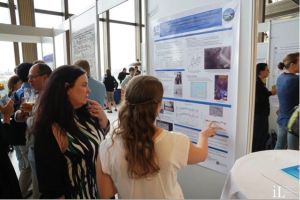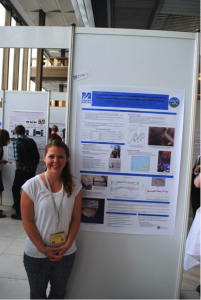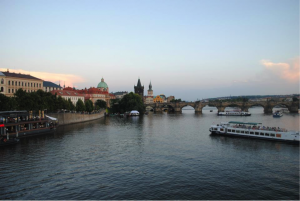Amy Johnston, Summer 2015
This summer I have been researching the paleoclimate of the Gulf of Maine during the recent Holocene (past 5,000 years). I have been working on the analysis of mollusk shells from the Turner Farm Site in North Haven, Maine, and sites on Nantucket Island, Massachusetts. The mollusk shells for this research project are from archaeological shell middens and will be used to study the stable isotopic chemistry and trace element chemistry of the samples. Stable isotope and trace element chemistry of midden shells will be conducted at both sites because they are located at the extreme north-south of the Gulf of Maine and therefore provide boundary conditions for the ocean chemistry across this time period. I plan to use stable isotope chemistry of the shells to reconstruct the paleothermometry at the sites and the trace element chemistry of the shells to determine other ocean conditions across this time period.
This research was made possible by my advisor, Robyn Hannigan, the Nantucket Field Station, and the Maine State Museum. I will be attending the Goldschmidt Geochemisty Conference in Prague from August 17th to the 22nd to present my preliminary trace element data that I collected during the month of July.
Over the summer I have been learning how to analyze shells and run samples on the Laser Ablation Inductively Coupled Plasma Mass Spectrometer (LA-ICP-MS) at the University of Massachusetts Boston, Environmental Analytical Facility, to gather my data. Geochemical proxies for past climate conditions can be used to provide important information about a region’s past environmental history. By linking these proxies to archeological data it will be possible to evaluate the longer-term interactions between humans and natural resources in the Gulf of Maine, a region currently faced with significant changes in shellfish population distributions due to climate warming and ocean acidification. Given the significant economic value of these species, understanding the longer-term trends in shellfish population distributions recorded in the middens will also provide much needed data on the management of these species under future climate change scenarios.

In addition, Amy Johnston, together with one of the IGERT program co-directors and principal investigators, Robyn Hannigan, traveled to Prague, Czech Republic in August, to attend the 2015 Goldschmidt International Conference in Geochemistry. The conference lasted for five days with talks, posters, and meetings held for roughly 3,000 participants. The Hannigan lab group presented their research projects throughout the week. Lab members also attended various talks and poster sessions related to their research interests.

For the 25th anniversary of the Goldschmidt Conference, the 2015 meeting featured 25 plenary talks that highlighted many different advances in Geochemistry over the past century. Amy’s research project poster was part of the “Environmental Proxies in Marine Carbonates: From Culturing Experiments to Archives and Diagenetic Alternation” poster session. In her poster, Amy presented her research looking at paleoclimate reconstruction of the Gulf of Maine during the recent Holocene (Past 5000 years) using archaeological mollusk shells. This past summer, Amy spent time in the lab analyzing mollusk shells from the Turner Farm Site in North Haven, Maine. Amy learned how to analyze shells and run samples on the Laser Ablation Inductively Coupled Plasma Mass Spectrometer (LA-ICP-MS) at the University of Massachusetts Boston, Environmental Analytical Facility. The presentation at Goldschmidt focused on the preliminary trace element data that she had collected during the month of July.

The 2015 Goldschmidt conference was a very rewarding experience for the Hannigan lab and provided group members with the opportunity to meet other researchers with similar research interests and projects. Robyn also had the honor of presenting a colleague of hers the 2015 Patterson Medal. The Goldschmidt conference exposed participants to a variety of geochemistry fields and allowed international collaboration in these different fields. Robyn and Amy had a great time in Prague and were very happy to have attended the conference!